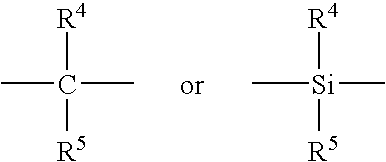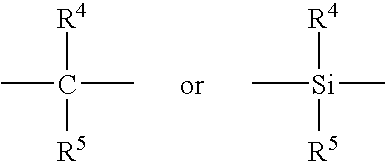Process for producing liquid polyalphaolefin polymer, metallocene catalyst therefor, the resulting polymer and lubricant containing same
a technology of metallocene catalyst and liquid polyalphaolefin, which is applied in the direction of lubricant composition, chemistry apparatus and processes, organic chemistry, etc., can solve the problem of difficulty in directly producing lubes in the lower viscosity range without incurring lower yields
- Summary
- Abstract
- Description
- Claims
- Application Information
AI Technical Summary
Benefits of technology
Problems solved by technology
Method used
Image
Examples
example 1
The dried 3 liter Büchi reactor was filled under argon with 750 ml of dry 1-decene monomer. To this, 1.15 ml of a 25% by wt. solution of triisobutylaluminum in hexane was added to scavenge moisture and impurities, and the reactor temperature was brought up to 70° C. Once the temperature reached 70° C., 1 mole of hydrogen gas was added to the reactor via pressure drop from a vessel of known volume. Then, a solution of 0.007 g of Ph2C(Cp-9-Flu)ZrCl2 was dissolved in 8.8 ml of a 10 wt. % solution of MAO in toluene, which had been prepared 30 minutes prior to its use, was injected into the stirring reactor under 200 psig argon pressure. The reactor was maintained at a temperature of 70° C. and 200 psig for a period of 30 minutes.
When complete, the reactor was depressurized and 400 ml hexane was added to the polymerized decene solution to aid in transfer. The reactor contents were then pressure transferred to a vessel equipped with an agitator containing 100 ml of acidified isopropanol, ...
example 2
The procedure of Example 1 was repeated with the same materials and amounts but using a higher temperature to note the dependence of polymer viscosity on reaction temperature. The reaction was set at an initial temperature of 95° C., then the reactor temperature was increased to 160° C. before bringing it back under control at its original setpoint. After polymerization and workup, 450 grams of polymeric material was obtained with a Mn of 3,780 and a polydispersity Mw / Mm Of 2.14. DSC analysis gave a glass transition temperature Tg of −76.6° C., with no indication of crystallinity. Kinematic viscosity measurements at 100° C. gave a viscosity of 144 cSt, and a viscosity index of 217. Unsaturation as measured by Iodine number was 3.75: 1H and 13C NMR analysis performed on this material indicated that there was no detectable unsaturation in the polymer. Polymer distribution analysis of the polymer demonstrated that the product was primarily syndiotactic in structure; the triad % rr resu...
example 3
The procedure of Example 1 was repeated using the same materials at 150° C. temperature and under reactor control (i.e., the reactor did not exhibit a significant exotherm) to prepare material comparable to a commercially available poly(1-decene) at 100 cSt viscosity. After polymerization and workup, 133 grams of polymeric material was obtained. Kinematic viscosity measurements at 100° C. gave a viscosity of 107 cSt, and a viscosity index of 210. Unsaturation as measured by Iodine number was 5.6.
A commercial sample of high viscosity poly(1-decene) known as Synton® PAO-100 available from Crompton Corporation (Middlebury, Conn.) was obtained and compared against the material synthesized. It's Kv at 100° C. was 100.3 cSt, and its VI was calculated at 171. Unsaturation as measured by Iodine number was 5.2. Thus, at comparable viscosities, the material of Example 3 exhibits an increase in viscosity index of 39 points, indicative of its improved temperature-viscosity behavior over the pri...
PUM
| Property | Measurement | Unit |
|---|---|---|
| polydispersity index | aaaaa | aaaaa |
| weight percent | aaaaa | aaaaa |
| weight percent | aaaaa | aaaaa |
Abstract
Description
Claims
Application Information
 Login to View More
Login to View More - R&D
- Intellectual Property
- Life Sciences
- Materials
- Tech Scout
- Unparalleled Data Quality
- Higher Quality Content
- 60% Fewer Hallucinations
Browse by: Latest US Patents, China's latest patents, Technical Efficacy Thesaurus, Application Domain, Technology Topic, Popular Technical Reports.
© 2025 PatSnap. All rights reserved.Legal|Privacy policy|Modern Slavery Act Transparency Statement|Sitemap|About US| Contact US: help@patsnap.com


